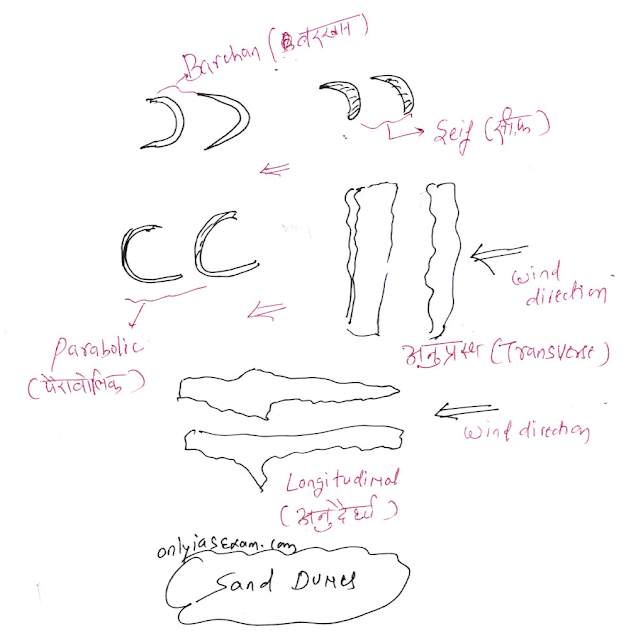Question
Write explanatory notes on Sand dunes. ( UPPSC 2007)
Answer.
Sand dunes are a type of deposited landform usually found in desert areas, but are not limited to desert areas, they are also found on beaches.
Sand dunes are heaps of sand (hill-like formations) mostly formed by the wind. It is the deposition function of winds in the desert and it is also the deposition function of waves (led by sea winds) on the beaches.
The dry hot desert has suitable sites for the formation of sand dunes. There are different types of sand dunes.
The sand dunes are of the following types:
- Crescent (Barchans) dune
- Parabolic dune
- Seif
- Longitudinal dune
- Transverse dune
- Mixed dunes.
Crescent dunes:
Crescent dunes, also known as Barchans, are found in abundance in sandy deserts. The shape of the crescent-shaped dunes is like the letter "C". The wings of the crescent-shaped dunes come out in the direction of the wind.
Parabolic Dunes:
The shape of the parabolic dunes is opposite to that of the Barchan dunes. They are formed where sandy deserts are partially covered with vegetation and the direction of the wind is constant.
Seif :
Seif dunes are similar to Brachan dunes but have only one wing.
Longitudinal dunes:
Longitudinal dunes are formed when sand is in short supply and the wind direction is constant. Longitudinal dunes are long ridges of low-height sand and they are formed in the same direction as the wind.
Transverse dunes:
When sand accumulates at the right angle of the direction of the wind, they are called transverse dunes.
Mixed Dunes:
When dunes form a mixture of longitudinal, barchan, and transverse dunes, they are called mixed dunes. Such dunes are formed when there is a sufficient amount of sand.
You may like also:

ConversionConversion EmoticonEmoticon